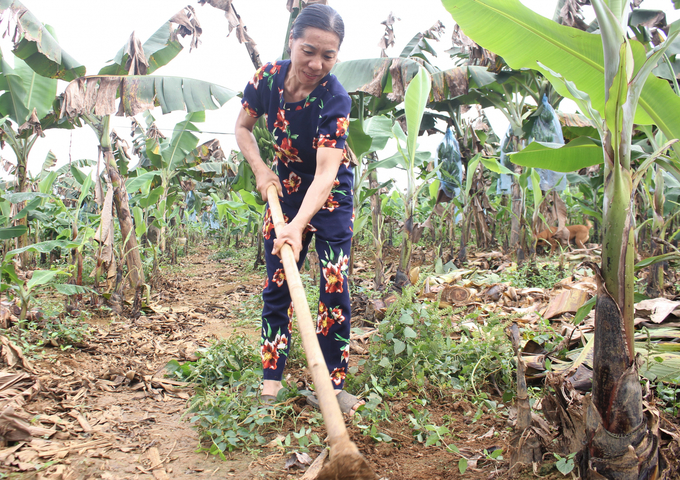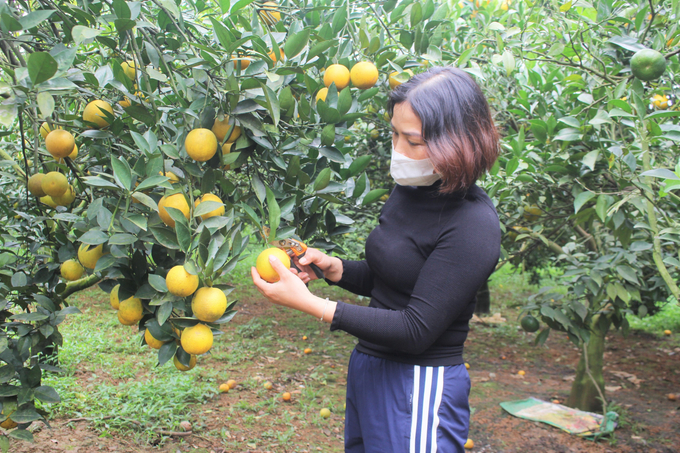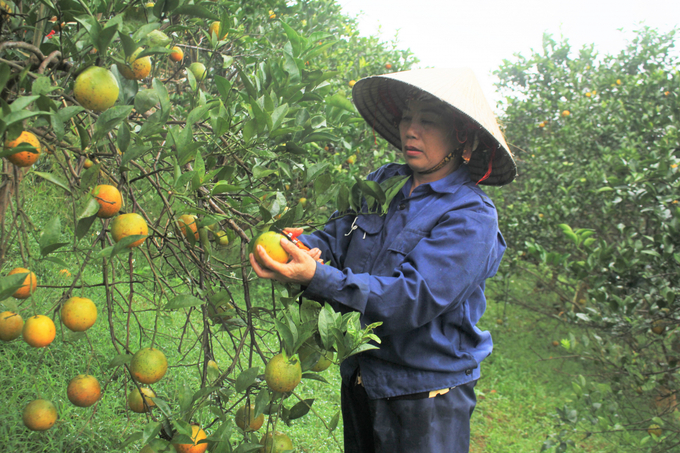[ad_1]
PEACE Thanks to the gradual conversion to organic farming and the control of seed quality, the orange area of Cao Phong (Hoa Binh) is gradually “reviving” after a period of decline, devastating diseases …
“Revival” of orange areas thanks to organic farming
Coming back to Cao Phong’s Orangery these days, it’s not hard to see the image of people and families busy picking oranges. A good sign is that this year’s orange price has remained at high levels since the start of the harvest and is expected to rise further towards the end of the season.
According to many households here, this joy is because in this year’s orange harvest, garden owners have made obvious changes in changing production methods to protect the Cao Phong brand of oranges, such as areas; new planting areas with disease-free seed sources; Farming according to safety standards, organic and organic guidelines to produce quality products …

According to Ms. Vu Thi Le Thuy, director of the Cao Phong 3T Orange Cooperative, organic and safe cultivation has helped Cao Phong oranges “revive” and develop in a sustainable way. Picture: Trung Quan.
Ms. Vu Thi Le Thuy, Director of Cao Phong 3T Orange Agricultural Cooperative (Cao Phong Town), said: The cooperative currently has more than 20 ha of oranges with an annual harvest of more than 300 tons. In order to protect the brand, improve competitiveness and develop the Cao Phong oranges in a sustainable way, there is no other way but to develop production in a safe and organic way to minimize the use of fertilizers, medicines, chemical pesticides, protecting the health of growers, restoring nutrients to the earth…
According to Ms. Thuy, the key issue for the production of quality oranges is the source of the seedlings and good soil. Therefore, she agreed with the members of the cooperative that new planting areas must use first-class trees from reputable and accredited farms. Also, limit chemical fertilizers by using eggs, soybeans, fish… soaked in probiotics to fertilize plants.
For healthy gardens with closed canopies, it is necessary to preserve natural grass to keep the garden moist in the dry season, prevent erosion in the rainy season, and provide a habitat for beneficial soil microorganisms, as well as other species…
For gardens in the initial stages of construction, cover crops short-term crops capable of adding nitrogen to the soil, such as soybeans, peanuts, green beans, sesame, etc. This will prolong the life of the trees, making them more calloused than in specialized gardens.
With the orange areas post-harvest to increase nutrition, improve plant resistance and have higher flowering and fruiting capacity in the next harvest, households apply fertilizer to the trees by spreading manure or earthworms on the surface, don’t dig, cause damage to the roots…
Mrs. Pham Thi Hien in District 1 (Cao Phong Town) could not hide her joy when 1ha of oranges, which are in her family’s recycling cycle after changing the cultivation method, were now sold at a high price. In addition, 1 ha recovers after the end of the use cycle as of 2018 after shedding the land by growing soybeans, bananas, etc.

Pham Thi Hien in Q1 (Cao Phong City) was thrilled to plant soybeans and bananas between two orange cycles, which helped return nutrients to the soil and ward off pathogens. Picture: Trung Quan.
“Golden oranges are currently sold in the garden at VND 20,000-22,000/kg, some households sell them at up to VND 25,000-30,000/kg, Canh oranges are at VND 40,000-45,000/kg, much higher than the same period last year. In addition, the cultivation of short-term crops helps the soil restore fertility and overcome the phenomenon of soil erosion. At the same time, growing soybeans and bananas helps the family maintain a source of income while providing raw materials for soaking and making organic fertilizer for use in the new orange cycle,” says Mr. Hien.
100% of the citrus varieties for replanting must be disease-free
Mr. Bui Van Dan, head of the Ministry of Agriculture and Rural Development of Cao Phong District, said: In 2022, the area of citrus trees (CAQCM) in the whole district will be more than 1,700 ha, which is 91% compared to the same period in the year 2021 (the area decreased due to the number of areas with citrus trees at the end of the business cycle, people cut down to replace new trees). The area of oranges is 1,357 ha (the area of trees in the business period is 1,328 ha); 73 ha of tangerines, more than 56 ha of lemons; grapefruit over 257 ha; Estimated production is over 20,000 tons.
According to Mr. Dan, Cao Phong District is currently promoting the implementation of Hoa Binh Provincial HQCM’s replanting project for the period 2021-2025, aiming at 2030 to regain the position for Cao Phong oranges and develop sustainably.

Organically grown orange groves have improved design and quality. Picture: Trung Quan.
Therefore, in the period from 2021 to 2025, focus on the replanting of CMs in Cao Phong District, the size of about 1,500 ha, making the total production area of Cao Phong District CAPs meet the following criteria:
– At least 75% of households producing AQCM are members of companies and cooperatives and are closely monitored for the cultivation process; Ensuring food safety and traceability of products.
– Arrange the structure of each parish/hamlet using only 1-2 key varieties to form single-variety planting areas that meet the area requirements to obtain a planting area code (minimum 10 ha/code). At the same time, the structure of the seed groups must be ensured in order to extend the harvest to the entire area (30% of the area with early-ripening varieties; 40% main crop varieties; 30% late-ripening varieties).
– 100% of the replanting area can be used with disease-free seed sources obtained from leader plants or from a 3-tier propagation system; Seedlings ensure the quality according to national standards.
– A technical package will be applied to 100% of the replanting areas to improve soil structure and soil fertility and create a pest-free soil fund before replanting.
– During the fiscal period, 100% of the district’s land area meets all food safety requirements, with over 85% of the area being Food Safety and Good Agricultural Practice (GAP) certified. , bio.

In the period from 2021 to 2025, Hoa Binh will focus on the replanting of citrus trees in Cao Phong district with a size of about 1,500 ha, especially on seedlings quality control and organic farming solutions. Picture: Trung Quan.
– The district will receive at least 50 growing area codes and 10 packing plant codes; At least 10 fresh fruit products or semi-processed and processed products are certified as OCOP products with 3 stars or more.
In addition, at least 70% of fresh fruit production is pre-processed to meet requirements, traceable to origin, before being placed on the market and consumed under the contract; 10% of fresh fruit production is processed.
– 100% of the concentrated planting area is supplied with active irrigation, of which 60% of the area is applied with advanced and water-saving irrigation solutions. Field-internal traffic system is concreted in concentrated production areas; 100% of the concentrated production area as well as preliminary stages and processing plants can use the national power grid.
[ad_2]
Source link

